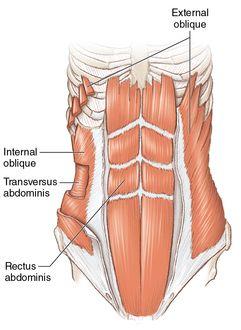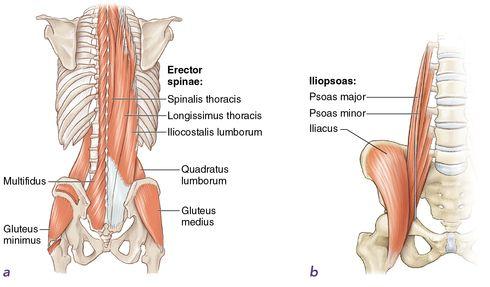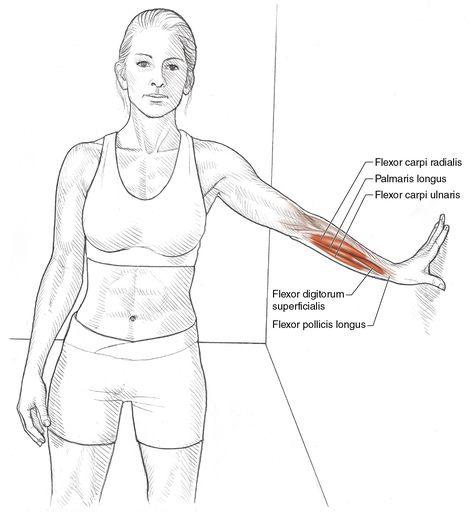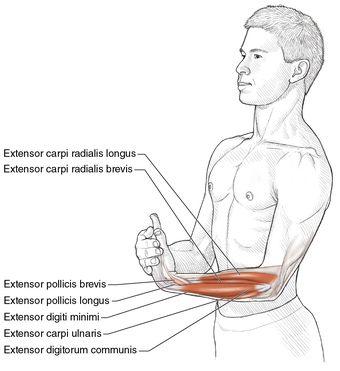Stretching Anatomy-2nd Edition (11 page)
Read Stretching Anatomy-2nd Edition Online
Authors: Arnold Nelson,Jouko Kokkonen
Tags: #Science, #Life Sciences, #Human Anatomy & Physiology

The elbow angle does not need to be precisely 90 degrees. Choose a comfortable angle. Some people find that fully flexing the elbow makes it easier to push on the hand. With the elbow fully flexed, the push is more down than across.
Wall-Assisted Finger Flexor Stretch
Execution
- Stand upright about one foot (30 cm) from a wall.
- Turn the body so that the left shoulder is perpendicular to the wall.
- Reach out and place the left fingertips on the wall midway between the left hip and left shoulder.
- While keeping only the left fingertips in contact with the wall, lean toward the wall.
- Repeat these steps for the opposite arm.
Muscles Stretched
- Most-stretched muscles:
Left flexor carpi radialis, left flexor carpi ulnaris, left flexor digiti minimi brevis, left flexor digitorum profundus, left flexor digitorum superficialis, left palmaris longus - Less-stretched muscles:
Left flexor pollicis longus
Stretch Notes
Tightness and hypertonicity of the finger flexors usually arise from making a fist or curling the wrists into flexion. Sleeping with the hands in this position causes the flexor muscle group to become even tighter and shorter, causing impingement and damage to the median nerve within the carpal tunnel. The finger flexors also become tight from repetitive work in which the hand is grasping something for a long period of time, such as when hammering or rock climbing. A person can also develop what is called trigger finger by overworking the index finger. Also, some of the problems of the forearm such as golfer’s elbow, or medial epicondylitis, are the result of tight finger flexor muscles. Finally, improper hand position in piano playing—wrist not relaxed, with a pushing action rather than a freely rebounding gravity stroke as the key stroke—can lead to finger flexor stiffness.
The initial starting height of your fingers relative to the hips is not critical. You should start in a position that makes it easy to maintain balance while still putting stretch tension on the muscles. As you adapt to the stretch, you may find it necessary to change the finger height to achieve the desired stretching tension.
Finger Extensor Stretch
Execution
- Sit or stand upright.
- Turn the left arm so that the left palm faces up. Flex the left elbow to a 90-degree angle.
- Flex the left wrist to a 90-degree angle. Flex the fingers so they point toward the elbow.
- Place the right hand on top of the fingers, and press the fingers down toward the forearm.
- Repeat these steps for the opposite arm.
Muscles Stretched
- Most-stretched muscles:
Left extensor carpi radialis brevis, left extensor carpi radialis longus, left extensor carpi ulnaris, left extensor digitorum communis, left extensor digiti minimi, left extensor indicis - Less-stretched muscles:
Left extensor pollicis brevis, left extensor pollicis longus
Stretch Notes
Tightness in the extensor muscles is also a cause of tennis elbow, pain in the lateral elbow during arm movements. This tightness usually is caused by overworking or straining these muscles. Therefore any activity that uses these muscles, such as keyboard work, racket sports, rowing, weightlifting, wheelchair sports, and rock climbing, can lead to overwork, hypertonicity, and tightness. Also, overworking the extensor pollicis longus and brevis or the abductor pollicis longus can lead to conditions known as drummer boy palsy (mainly the extensor pollicis longus) and de Quervain syndrome (mainly the extensor pollicis brevis and abductor pollicis longus). A tight extensor carpi radialis longus or extensor carpi radialis brevis can also lead to inflammation of their respective tendons, which can lead to radial wrist pain or intersection syndrome. By doing this stretch, you help reduce the problems that can arise from overworked finger extensors. Finally, ability to do active finger extension is used as a reliable early predictor of recovery of arm function in stroke patients. Thus, stretching the finger extensor muscles after a stroke helps in the rehabilitation process.
Increase the magnitude of the stretch by flexing the fingers (i.e., make a fist). Also, the elbow angle does not need to be precisely 90 degrees. Choose a comfortable angle. Some people find that fully flexing the elbow makes it easier to push on the hand. With the elbow fully flexed, the push is more down than across.
Chapter 4
Lower Trunk
The 12 thoracic vertebrae, 5 lumbar vertebrae, sacrum, ribs, and pelvic bones along with associated muscles and ligaments make up the flexible framework of the trunk. The vertebrae and the other bones, muscles, and ligaments work together to support and move the trunk. As in the neck, the vertebral bodies (the oval-shaped bones) of the trunk are connected by posterior and anterior ligaments along with other ligaments that connect each spinous and transverse (lateral bony protuberance) process to its corresponding part on the adjacent vertebrae. In addition, each vertebra is separated by an intervertebral disc. Compression of the vertebrae upon the discs allows the trunk to move forward, backward, and sideways, with the amount of movement limited in part by the vertebral facets.
The trunk movements are flexion (moving the chest and thighs toward each other), extension (moving the chest and thighs away from each other), hyperextension (moving the trunk back away from an erect position), lateral flexion and extension (shoulders tipped back and forth sideways), and rotation.
Since many of the muscles in the trunk come in right and left pairings, all these muscles are involved in lateral flexion, lateral extension, and rotation. For example, the right external oblique and internal oblique abdominal muscles help perform right lateral flexion, and the left external oblique and internal oblique abdominal muscles help perform right lateral extension. Several of the muscles involved in movements of the lower trunk run between the pelvic bones and either the spinal column or rib cage.
The external oblique, internal oblique, and rectus abdominis of the abdomen (
figure 4.1
) and quadratus lumborum (
figure 4.2
a
) flex the trunk by pulling the rib cage toward the pelvis. The iliacus (
figure 4.2
b
), a trunk flexor, pulls the femur (thigh bone) toward the pelvis. The psoas major, another trunk flexor, pulls the spinal column toward the femur. The prime trunk extensors (iliocostalis lumborum, longissimus thoracis, and spinalis thoracis) are collectively called the erector spinae. The iliocostalis lumborum runs between the posterior pelvis and posterior spinal column, while the longissimus thoracis and spinalis thoracis run along the posterior spinal column and help the individual vertebrae in the spinal column work together as a single unit. The interspinales, intertransversarii, multifidus, and rotatores run between individual vertebrae and cause large movements by making small changes between individual pairs or groups of vertebrae.
Figure 4.1
Abdominal muscles.

Figure 4.2
Core muscles:
(a)
posterior;
(b)
anterior.

The ability to move the trunk is limited by the strength of the contracting muscles, the stiffness of the opposing ligaments, the stiffness of the noncontracting muscles, the alignment of the vertebral bodies with the adjacent vertebrae, the compressibility of the intervertebral discs, and the contact between body parts. For example, trunk flexion is limited by the stiffness of the posterior trunk muscles, the stiffness of the posterior trunk ligaments, the strength of the anterior trunk muscles, the alignment of the vertebral bodies with the adjacent vertebrae, the compressibility of the anterior portions of the intervertebral discs, the contact of the chin or rib cage with the legs, and the abdominal fat mass. Similarly, trunk extension is controlled by the stiffness of the anterior trunk muscles, the stiffness of the anterior trunk ligaments, the strength of the extensor muscles, the alignment of the vertebral bodies with the adjacent vertebrae, and the compressibility of the posterior portions of the intervertebral discs. In addition to the factors listed for flexion and extension, trunk lateral movement is controlled by the impingement of each vertebra’s transverse process on the adjacent transverse processes. Trunk rotation is limited by the stiffness of spinal ligaments, the strength of the muscles on the side of rotation, the stiffness of the muscles opposite the side of rotation, and body tissues and their dimensions. For instance, rotating to the left is limited by weak left-side muscles and tight right-side muscles.
Many people who have stiff back muscles have discovered that stretching helps relieve some of the pain. The back muscles, or trunk extensors, are not the only lower-trunk muscles to influence back pain. Often people find relief from back pain by leaning back (trunk hyperextension) because this action stretches the abdominal muscles, the trunk flexors. This shows that flexible trunk flexors are also important. Moreover, numerous sporting activities such as golf, tennis, and throwing sports require twisting of the trunk. Twisting the trunk involves the trunk extensors, flexors, and lateral flexors. Improved range of motion of all lower-trunk muscles can increase the range of motion in trunk rotation and improve the performance in activities that involve these actions.
Hyperextension (arching) and hyperflexion (bending) of the lower back are potentially dangerous, especially if you have weak abdominal, thigh, and buttocks muscles. Backward rolling movements are potentially dangerous to the cervical spine (neck). Potential injuries include excessively squeezing the spinal discs, jamming together the spinal joints, and pinching the spinal nerves emerging from the lumbar vertebrae. If you choose to perform these stretches, build up to them more gradually than most other stretches. Also, to keep pressure off the neck during back rolls, keep the shoulder blades in contact with the floor.


